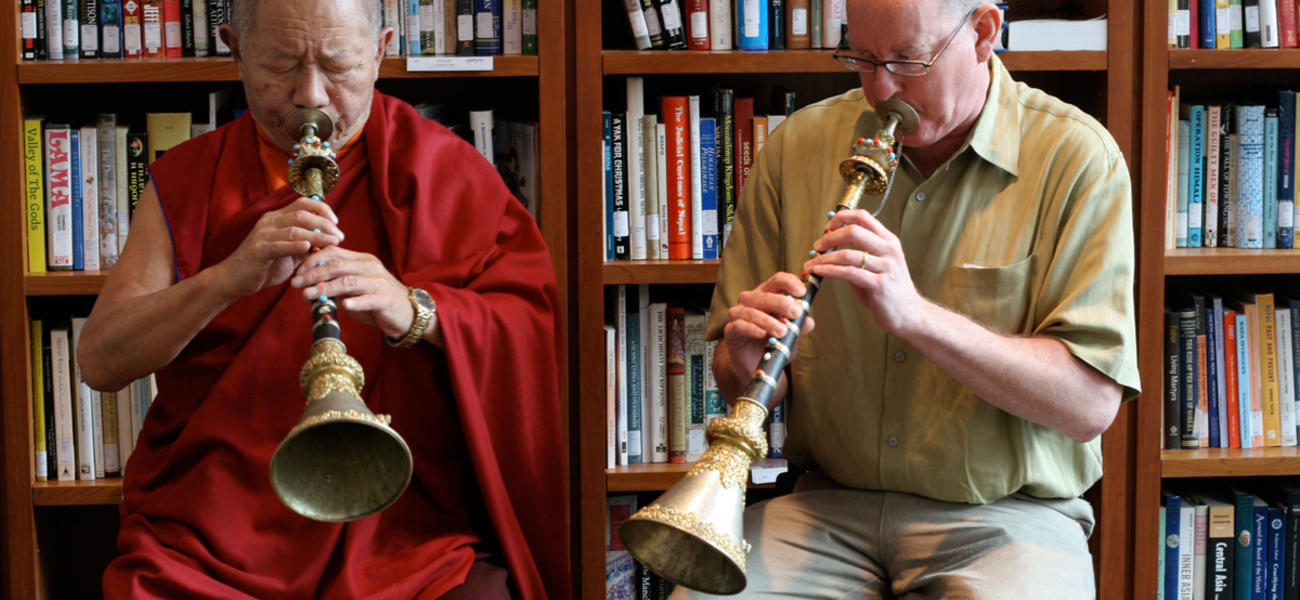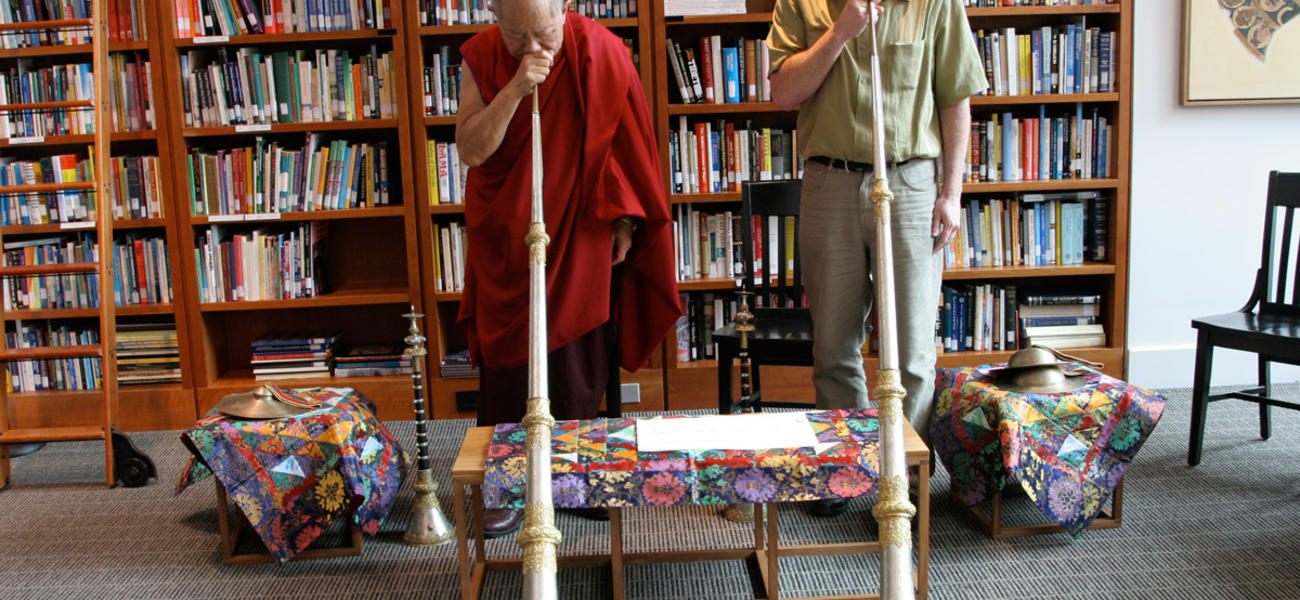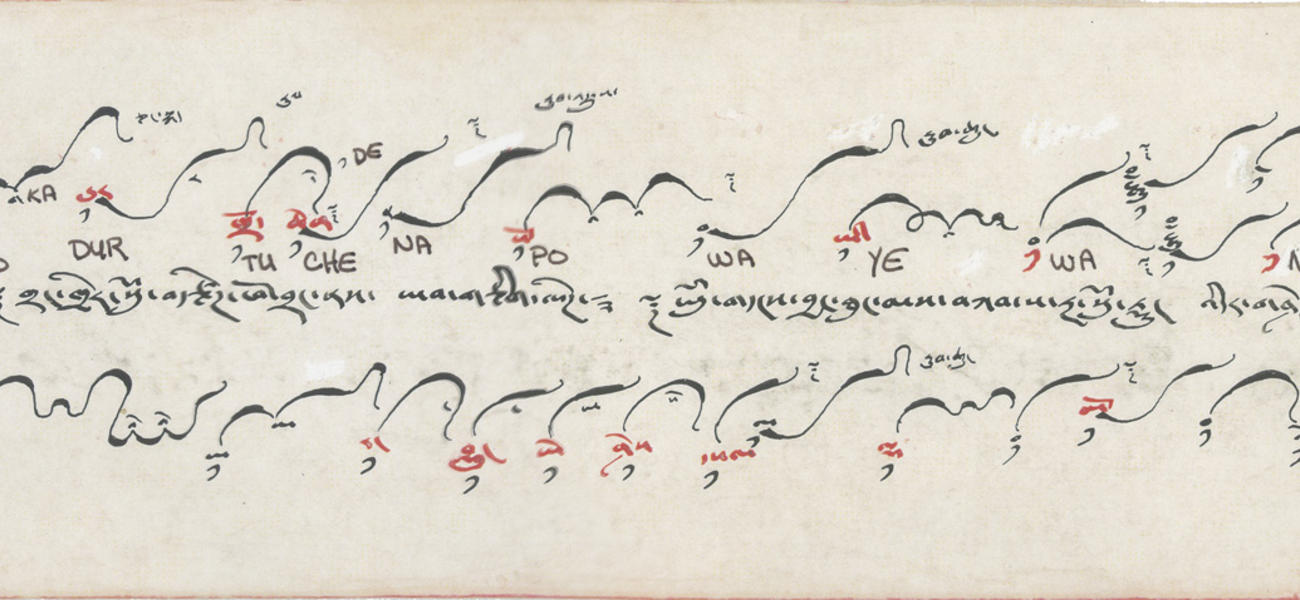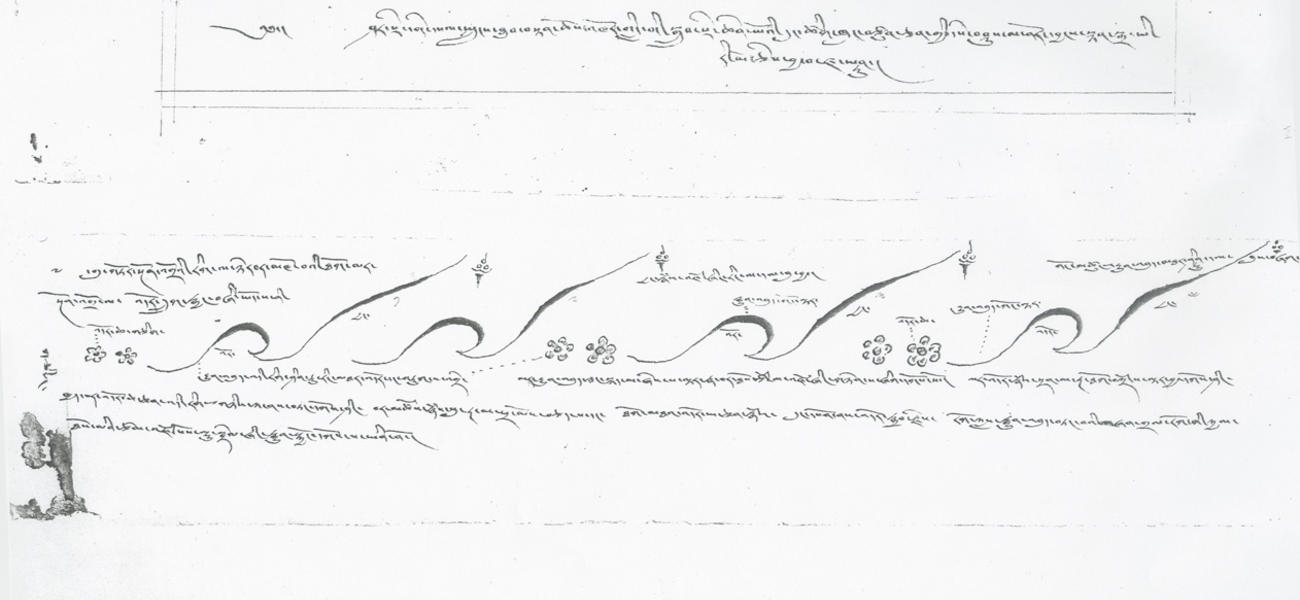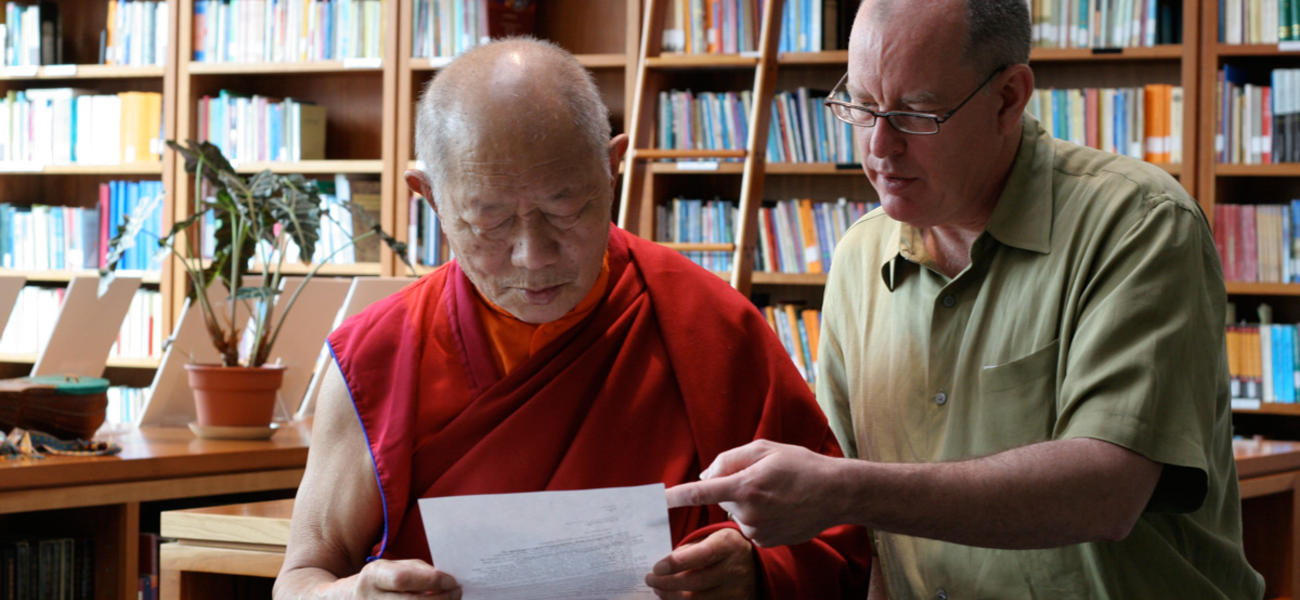How lucky I feel to have learned about the musical event given by Phursang Kelak Lama and Michael Monhart at Trace Foundation’s Latse Library, Saturday, June 12. The color, purity, and devotion of the music turned a demonstration into an offering.
The performance began with long bronze trumpets (dungchen), but to say “trumpet” can be misleading. These were not the short horns a Westerner is used to seeing, but very long ceremonial instruments that touched or nearly touched the floor when placed to lips in a seated position. The sound was very deep, reminiscent of deep chanting. What seemed repetitive had subtle variations in rhythm and tone, a semi-percussive use of a wind instrument.
The second instrument played was the gyaling, a reed instrument something like an oboe, which was also called a flute. It was higher pitched, insistent, more yang, foreground, in your face, a wake up call. At first I thought it would be grating but it was deeply pleasing, sharp, stimulating. I thought of a child’s voice and the high pitched sound of birds. The gyaling resonated in my chest, the dungchen someplace deeper in my body or deeper than my body.
We learned that a note in Tibetan ritual music is like a phrase, a rhythmic or tonal series. When I heard this I thought not only of the series of sounds in a bird’s repetitive song, but of John Dewey’s and Alfred North Whitehead’s description of aesthetic and feeling time—the experiential sequence one goes through in viewing a work of art or going through a particular feeling state, an experiential arc rather than clock time.
For the final demonstration, Phursang Lama chanted and played cymbals and Michael played a drum. The chant was deep voiced and the cymbals were touched in a way that ended in something of a quiver, a light, barely perceptible flutter which gave me shivers.
The question-answer and interview time was revealing. When asked what he felt when he played, Phursang Lama said he was trying to make sounds pleasing to the buddhas and bodhisattvas. He pointed to his ear, suggesting aural pleasure, fine attunement. He pictured deities, angels, buddhas and bodhisattvas and the pleasure this music might give them. When asked about the bardo—the period in Tibetan Buddhist thought between death and rebirth— he spoke of the music as preparation, accumulating merits, but also allaying fear, so that in bardo one would not be afraid and could hear the Buddhas and Bodhisattvas’ singing.
Phursang Lama spoke of the ceremonial and celebratory use of the music, played when important people visited the monastery, as well as usual ritual use. One person asked if new ritual music was being written and Phursang Lama said no: he played traditional music. Throughout the afternoon, he read from musical scores. A slight disagreement arose as to whether one of the instruments had roots in India or China. Phursang Lama thought China and a man from the audience suggested India. Phursang Lama raised his hands to his head and kept them there quietly.
Most Western music is based on diachronic or chromatic tones. You move whole or half steps between well defined single notes. There are ways of trying to get around this, via glissandos or a player varying tones slightly as feeling dictates. Electronic music opens realms between the single notes. Sometimes a player or composer hits an off tone that is particularly suggestive, tantalizing, juicy, eerie, mysterious, delicate. The Tibetan music we heard seemed to emphasize between moments, off tones which open fields of experience otherwise closed. I was struck by what seemed like home base tones becoming staging grounds for quivering variations, vibrations, tremolos that open dormant body states. At times, I felt my body was being retuned, kind of a spiritual acupuncture.
On a radio show I happened to tune into a few weeks ago, I heard what a scientist claimed was a computer representation of the background sound of the universe. A high pitched sound (the gyaling) fused with very low sounds (dungchen) in off-tonal modes. I couldn’t help wondering if Tibetan ritual music channeled this, tuned into it, or whether the coincidence is part of deep processes of which we have intimations.
My favorite parts of the Latse concert were the trumpets, cymbals and chants. The trumpets, especially, touched me in unknown places hungry for touch. The sounds were at once stabilizing, mysterious, opening. They seemed to come from beyond the self and, paradoxically, their gravelly sounds dispelled the fog. The cymbals, which usually clang and make loud sounds, were used as a delicate instrument, almost silken, creating ripples, nuanced currents, which made my spine and inside skin tingle. Tibetan chanting I’ve heard before, always enchanting and much more. Trumpets played first, chants last, but fused deep inside. It’s always good to hear the real thing.
Phursang Kelak entered a monastery in Tibet when he was thirteen. Apparently it was not uncommon to do that for education. By his late teens his musical studies began, and continued ever since, five or six decades later. He left Tibet with other senior lamas in 1959 and settled in Kathmandu, where he is currently ritual music director of Karma Raj Mahavihar, a Kagyu monastery located at Swayambhu.
He and Michael Monhart met at the University of Washington, where Phursang Kelak Lama taught Tibetan ritual music for two years and where Michael received a Masters of Arts in Ethnomusicology, specializing in ritual musics of Tibet and Japan. Michael then worked in the multimedia education department at Microsoft for 12 years and is presently a Master of Arts student in Tibetan Studies at Columbia University.
Meeting Phursang Kelak Lama and Michael Monhart was a perfect end for this wonderful afternoon. Although we had a language barrier, Phursang Lama touched my hand and my core with his gentle, warm, strong face. It was a pleasure to exchange a few words with Michael about the music. He is an accomplished saxophonist and creative musician in his own right, a dedicated translator of Buddhist work, deeply immersed in Tibetan studies. I don’t see how the buddhas, bodhisattvas and deities could fail to be pleased by what Phursang Lama and Michael offered us.
Michael Eigen, PhD, is a practicing psychologist and the author of Flames from the Unconscious: Trauma, Madness and Faith, Feeling Matters and The Psychoanalytic Mystic.

